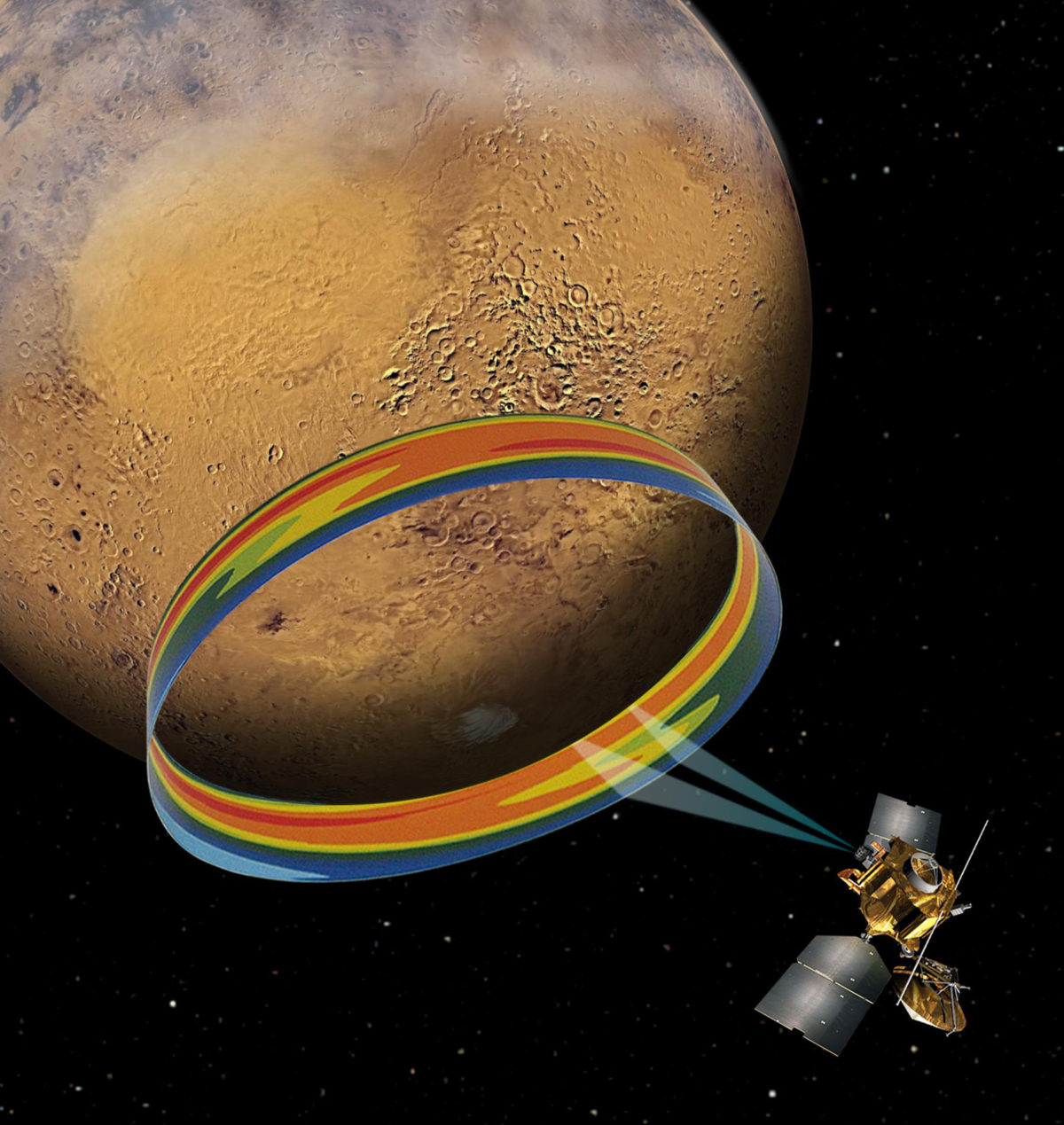Armin Kleinboehl • Aug 07, 2013
Mysterious tides in the Martian atmosphere
Observations made by the Mars Climate Sounder, an instrument aboard NASA’s Mars Reconnaissance Orbiter, have revealed new information about atmospheric tides on the Red Planet.
Atmospheric tides are the regular, repeating patterns of changes in pressure, temperature and wind in a planet’s atmosphere that occur over the course of a solar day. In contrast to ocean tides, they are driven by variations in heating between day and night. Earth also has atmospheric tides, but their effect is significant mostly in the upper atmosphere. On Mars, however—which has about one percent as much atmosphere as Earth—atmospheric tides are the driving force of short-term temperature and wind changes throughout the planet’s entire atmosphere.
Until recently scientists believed Mars’ atmospheric tides were predominantly diurnal, meaning there is one temperature minimum and maximum per Martian day. The new MCS observations have revealed a global, semi-diurnal tide, which means we see two temperature maximums every day—one in the middle of the day and one around midnight. During this twice-daily cycle, differences between maximum and minimum temperatures can be as high as 58° F (32 K). This is the largest tidal amplitude observed in the Martian middle atmosphere outside of a dust storm.

These measurements were made possible by a special MCS observation sequence. MCS is an infrared thermal emission radiometer, which allows it to take the temperature of the Martian atmosphere. It typically looks toward the forward horizon in the direction MRO is travelling (called “in-track”). MRO is in a sun-synchronous orbit. It takes measurements at local morning and afternoon times as it travels around the planet. For this study, we programmed MCS to swivel around its azimuth axis towards the left and right horizon (called “cross-track”). This allowed it to observe not only at different locations but also at different local times. A specially-designed sequence alternated in-track and cross-track measurements, enabling additional morning and afternoon observations.
Scientists have known about Mars’ semi-diurnal tides since the 1970s, but the twice-daily osciallation was thought to appear only in dusty seasons, when sunlight warms dust in the atmosphere. The new MCS data show that the pattern is dominant globally and year-round.
In order to investigate the cause of the semi-diurnal tide, we used a sophisticated computer simulation called a Mars General Circulation Model. MGCMs simulate the Martian atmosphere based on physical conditions like topography, atmospheric composition, and energy input. They are similar to the weather and climate models used for simulating Earth’s atmosphere. Our results indicated water-ice clouds are the driver of the semi-diurnal tides.
The Martian atmosphere has water-ice clouds for most of the year. Clouds in the equatorial region between about 6 to 19 miles (10 to 30 km) above the surface of Mars absorb infrared light emitted from the surface during daytime. These are relatively transparent clouds, like thin cirrus clouds on Earth. Still, the absorption by these clouds is enough to heat the middle atmosphere each day. Although we did not expect to see the twice-daily maximum temperature swings occurring away from the tropics, the MGCMs matched our observations when the radiative effects of water-ice clouds were included.
Water-ice clouds have been known to form in regions of cold temperatures in the Martian atmosphere, but the effects of these clouds had not been appreciated. We know now that we will have to consider the clouds if we want to fully understand the Martian atmosphere.
In order to accurately simulate global atmospheric temperatures and circulation, the MGCMs will require that the vertical distributions of cloud and dust and their radiative effects are taken into account. This is comparable to current challenges faced by weather and climate models here on Earth, which require modeling of clouds and other particles in the atmosphere to consider their effects on climate.
These results were published as a frontier article in the journal Geophysical Research Letters. JPL also issued a press release that summarizes the results.
Reference: Kleinböhl, A., R. J. Wilson, D. Kass, J. T. Schofield, and D. J. McCleese (2013), The semidiurnal tide in the middle atmosphere of Mars, Geophys. Res. Lett., 40, 1952–1959, doi:10.1002/grl.50497.
Support our core enterprises
Your support powers our mission to explore worlds, find life, and defend Earth. You make all the difference when you make a gift. Give today!
Donate

 Explore Worlds
Explore Worlds Find Life
Find Life Defend Earth
Defend Earth

